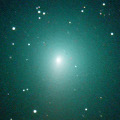
|
Now it is very bright as 7.1 mag (Mar. 24, Maik Meyer). It approaches to the earth down to 0.14 a.u. from March to April, and brightens up to 5-6 mag. It may brighten furthermore in outburst. It is observable in excellent condition in the Northern Hemisphere. In the Southern Hemisphere, it will not be observable for about one month from late March to late April.
Date(TT) R.A. (2000) Decl. Delta r Elong. m1 Best Time(A, h)
Mar. 25 11 38.07 58 42.9 0.146 1.076 119 6.1 23:33 (180, 66)
Apr. 1 13 26.10 64 35.4 0.142 1.057 110 5.6 0:43 (180, 61)
|
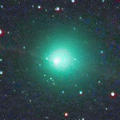
|
Now it is bright as 7.2 mag (Mar. 24, Marco Goiato). In the Southern Hemisphere, it stays observable after this while the comet will be fading. In the Northern Hemisphere, it stays unobservable until May when it becomes fainter than 14 mag.
Date(TT) R.A. (2000) Decl. Delta r Elong. m1 Best Time(A, h)
Mar. 25 22 36.53 -16 46.3 0.802 0.512 30 7.8 4:32 (284, -9)
Apr. 1 22 32.48 -17 59.8 0.907 0.640 38 9.0 4:21 (288, -5)
|
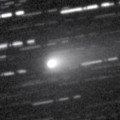
|
Now it is 9.2 mag (Mar. 15, Thomas Lehmann). It is expected to brighten up to 7 mag from April to May. It locates somewhat low at the high light.
Date(TT) R.A. (2000) Decl. Delta r Elong. m1 Best Time(A, h)
Mar. 25 19 54.72 -19 0.7 1.287 1.289 67 8.1 4:32 (312, 19)
Apr. 1 20 29.61 -16 30.7 1.235 1.226 65 7.8 4:21 (307, 18)
|
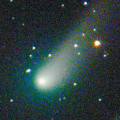
|
Now it is 9.5 mag (Mar. 22, Seiichi Yoshida). It is expected to brighten up to 6-7 mag from April to July. In the Northern Hemisphere, it stays observable in excellent condition until June. In the Southern Hemisphere, it stays extremely low for a while.
Date(TT) R.A. (2000) Decl. Delta r Elong. m1 Best Time(A, h)
Mar. 25 16 32.11 47 25.8 1.420 1.945 105 8.7 4:22 (180, 78)
Apr. 1 16 31.28 47 35.8 1.338 1.898 107 8.4 3:54 (180, 77)
|
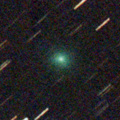
|
Bright new comet. Brightening rapidly. Now it is bright as 10.1 mag (Mar. 22, Michael Mattiazzo). In the Northern Hemisphere, it stays observable until late April while the comet will be brightening gradually. In the Southern Hemisphere, it becomes unobservable in early April.
Date(TT) R.A. (2000) Decl. Delta r Elong. m1 Best Time(A, h)
Mar. 25 20 32.66 -8 38.1 0.641 0.837 56 10.8 4:32 (297, 20)
Apr. 1 21 38.28 9 51.9 0.608 0.721 45 10.0 4:21 (274, 22)
|

|
It has not been observed yet in this apparition. The condition of this apparition is worst. It will brighten up to 10 mag in spring, but not observable at all.
Date(TT) R.A. (2000) Decl. Delta r Elong. m1 Best Time(A, h)
Mar. 25 0 25.21 6 26.9 2.116 1.127 5 12.2 19:40 (108,-13)
Apr. 1 0 52.93 8 25.0 2.092 1.100 4 11.9 19:46 (111,-13)
|
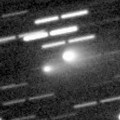
|
Now it is 12.2 mag (Mar. 6, Chris Wyatt). Bright new fragment BT was discovered on Feb. 10. Now the fragment BT is fainter than the primary component. In the Southern Hemisphere, it stays observable for a long time after this. In the Northern Hemisphere, it is not observable temporarily until mid June.
Date(TT) R.A. (2000) Decl. Delta r Elong. m1 Best Time(A, h)
Mar. 25 21 44.37 -17 35.8 1.458 0.979 41 12.1 4:32 (293, 1)
Apr. 1 22 15.55 -15 51.1 1.496 0.996 41 12.3 4:21 (289, 0)
|
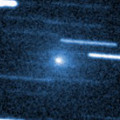
|
Bright new comet. Now it is 12.2 mag (Mar. 3, Seiichi Yoshida). It stays 12-13 mag until May. In the Southern Hemisphere, it stays observable for a long time, but it stays low. It will not be observable in early April in the Northern Hemisphere. Juan Jose Gonzalez reported it is very bright as 9.7 mag on Mar. 20.
Date(TT) R.A. (2000) Decl. Delta r Elong. m1 Best Time(A, h)
Mar. 25 21 18.03 -7 6.8 1.331 0.946 45 12.9 4:32 (288, 13)
Apr. 1 21 56.16 -5 36.3 1.356 0.915 42 12.8 4:21 (284, 10)
|
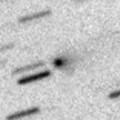
|
Now it is 16.4 mag (Mar. 8, Thomas Lehmann). It is expected to brighten up to 10 mag in summer. But actually, it is much fainter than this ephemeris recently. It will be observable in excellent condition in the Southern Hemisphere. It locates low in the Northern Hemisphere.
Date(TT) R.A. (2000) Decl. Delta r Elong. m1 Best Time(A, h)
Mar. 25 16 11.10 -14 35.5 1.107 1.828 120 13.3 4:02 ( 0, 40)
Apr. 1 16 19.27 -15 25.0 1.024 1.798 125 13.0 3:42 ( 0, 40)
|
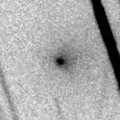
|
It brightened very rapidly. Now it is bright as 13.2 mag (Mar. 15, Piotr Guzik). Small comet, but it approaches to the sun down to 0.9 a.u., and to the earth down to 0.5 a.u. It is observable in excellent condition in the Northern Hemisphere. In the Southern Hemisphere, it stays observable only until mid February.
Date(TT) R.A. (2000) Decl. Delta r Elong. m1 Best Time(A, h)
Mar. 25 3 35.58 61 44.3 0.536 0.963 70 13.8 19:40 (146, 43)
Apr. 1 4 35.76 70 54.6 0.528 1.010 75 14.9 19:46 (159, 44)
|

|
Appearing in the morning sky. Now it is 15.3 mag (Mar. 5, CAO, San Pedro de Atacama).
Date(TT) R.A. (2000) Decl. Delta r Elong. m1 Best Time(A, h)
Mar. 25 21 15.45 -16 27.5 6.476 5.856 48 13.8 4:32 (296, 7)
Apr. 1 21 19.86 -16 3.2 6.388 5.855 53 13.8 4:21 (297, 10)
|
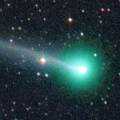
|
It approached to the earth down to 0.08 a.u. in mid February, and brightened up to 6.5 mag (Feb. 10, Danil Sidorko). Now it is fading rapidly. It has already faded down to 11.2 mag (Mar. 19, Osamu Miyazaki).
Date(TT) R.A. (2000) Decl. Delta r Elong. m1 Best Time(A, h)
Mar. 25 10 33.08 20 33.4 0.620 1.552 146 13.8 22:21 ( 0, 75)
Apr. 1 10 31.77 19 21.7 0.743 1.640 140 14.6 21:52 ( 0, 74)
|
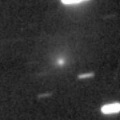
|
Now it is bright as 14.4 mag (Jan. 14, Thomas Lehmann). It is not observable now in the Northern Hemisphere. It will be unobservable temporarily in May also in the Southern Hemisphere. It will be getting higher gradually in the morning sky after summer. Then it will be observable at 11 mag for a long time from 2017 autumn to 2018 winter.
Date(TT) R.A. (2000) Decl. Delta r Elong. m1 Best Time(A, h)
Mar. 25 3 8.32 -20 45.3 5.438 4.825 47 14.5 19:40 ( 62, 3)
Apr. 1 3 13.12 -19 28.3 5.436 4.773 44 14.5 19:46 ( 68, -2)
|
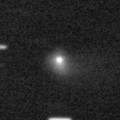
|
Small outburst occured in mid March. Now it is 13.5 mag (Mar. 15, J.P.Navarro Pina). It is observable in excellent condition in the Northern Hemisphere. It stays low in the Southern Hemisphere.
Date(TT) R.A. (2000) Decl. Delta r Elong. m1 Best Time(A, h)
Mar. 25 11 40.82 32 11.3 1.684 2.566 145 14.6 23:28 ( 0, 87)
Apr. 1 11 36.58 31 42.3 1.732 2.584 140 14.7 22:56 ( 0, 87)
|
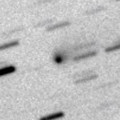
|
Now it is 15.4 mag (Feb. 25, T. Ikemura, H. Sato). It will brighten up to 14 mag from spring to summer. It locates somewhat low in the Northern Hemisphere. The perihelion distance increased from 2.4 a.u. to 2.9 a.u. in this apparition. So it will not be bright as before.
Date(TT) R.A. (2000) Decl. Delta r Elong. m1 Best Time(A, h)
Mar. 25 16 29.44 -19 46.1 2.518 3.082 115 14.7 4:20 ( 0, 35)
Apr. 1 16 30.99 -20 1.9 2.422 3.072 122 14.6 3:54 ( 0, 35)
|
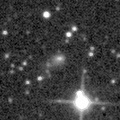
|
Now it is 15.7 mag (Mar. 7, Kunihiro Shima). It will be observable at 13 mag for a long time from 2017 to 2018.
Date(TT) R.A. (2000) Decl. Delta r Elong. m1 Best Time(A, h)
Mar. 25 19 11.53 4 15.6 4.855 4.714 75 15.0 4:32 (303, 44)
Apr. 1 19 10.52 5 32.5 4.706 4.678 82 14.9 4:21 (306, 48)
|
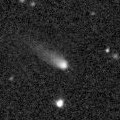
|
Now it is 15.6 mag (Feb. 15, Alexander Baransky). It will brighten up to 12-13 mag and will be observable in good condition in summer. Now it is not observable. It will appear in the morning sky in May.
Date(TT) R.A. (2000) Decl. Delta r Elong. m1 Best Time(A, h)
Mar. 25 0 14.74 13 29.8 4.132 3.162 11 15.1 4:32 (245,-10)
Apr. 1 0 16.39 13 39.3 4.102 3.127 11 15.0 4:21 (247, -7)
|

|
Now it is 15.6 mag (Mar. 6, Kunihiro Shima). Now it is not observable. But it will appear in the morning sky in June in the Southern Hemisphere, or in July in the Northern Hemisphere. Then it stays observable at 15.5 mag unil the end of 2017.
Date(TT) R.A. (2000) Decl. Delta r Elong. m1 Best Time(A, h)
Mar. 25 1 43.68 0 37.9 6.258 5.347 21 15.3 19:40 ( 92, -1)
Apr. 1 1 50.01 1 6.8 6.312 5.367 17 15.3 19:46 ( 96, -7)
|
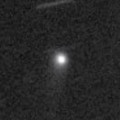
|
Now it is 15.3 mag (Dec. 29, Kunihiro Shima). Now it is not observable. In the Northern Hemisphere, it will appear in the morning sky in late April. Then it will brighten up to 14 mag from summer to next winter, and it will be observable in excellent condition. In the Southern Hemisphere, it will be observable in the very low sky only from May to June.
Date(TT) R.A. (2000) Decl. Delta r Elong. m1 Best Time(A, h)
Mar. 25 23 41.04 11 27.8 4.574 3.609 13 15.4 4:32 (252, -5)
Apr. 1 23 46.32 13 9.3 4.528 3.579 16 15.3 4:21 (252, -2)
|
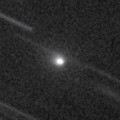
|
Now it is 15.0 mag (Feb. 25, Alexander Baransky). It stays 15 mag until spring. But it is already unobservable in the Southern Hemisphere. It will be getting lower gradually after this also in the Northern Hemisphere.
Date(TT) R.A. (2000) Decl. Delta r Elong. m1 Best Time(A, h)
Mar. 25 2 38.34 24 50.8 2.333 1.717 41 15.4 19:40 (105, 23)
Apr. 1 2 59.38 26 12.8 2.378 1.729 39 15.4 19:46 (108, 21)
|

|
It has not been observed yet in this apparition. It will brighten up to 12 mag in summer. It will be observable in excellent condition in the Southern Hemisphere. It locates somewhat low in the Northern Hemisphere.
Date(TT) R.A. (2000) Decl. Delta r Elong. m1 Best Time(A, h)
Mar. 25 18 24.40 -33 15.9 2.206 2.407 89 15.7 4:32 (338, 18)
Apr. 1 18 35.34 -33 20.4 2.097 2.380 93 15.4 4:21 (339, 18)
|

|
Now it is 15.7 mag (Feb. 23, T. Ikemura, H. Sato). It stays 16-17 mag for a long time from 2016 to 2019. It stays near by the equator.
Date(TT) R.A. (2000) Decl. Delta r Elong. m1 Best Time(A, h)
Mar. 25 9 5.38 5 1.8 8.908 9.603 131 15.9 20:53 ( 0, 60)
Apr. 1 9 4.97 5 20.3 8.990 9.599 125 15.9 20:25 ( 0, 60)
|

|
It brightened up to 11 mag from spring to summer in 2016. It is appearing in the morning sky again. Now it is 16.5 mag (Mar. 4, T. Ikemura, H. Sato). It will be observable at 16-17 mag in good condition from spring to summer.
Date(TT) R.A. (2000) Decl. Delta r Elong. m1 Best Time(A, h)
Mar. 25 19 57.79 -18 48.4 2.942 2.705 66 15.9 4:32 (311, 19)
Apr. 1 20 5.58 -18 25.7 2.892 2.745 71 16.0 4:21 (312, 21)
|

|
Now it is 16.3 mag (Feb. 25, Alexander Baransky). It stays observable at 16 mag until June. It locates low in the Southern Hemisphere.
Date(TT) R.A. (2000) Decl. Delta r Elong. m1 Best Time(A, h)
Mar. 25 6 49.16 27 31.5 3.442 3.692 96 16.0 19:40 ( 65, 75)
Apr. 1 6 52.96 27 24.8 3.537 3.685 90 16.1 19:46 ( 75, 69)
|
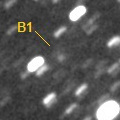
|
Now it is 17.3 mag (Mar. 3, T. Ikemura, H. Sato). It was observed at 16 mag from spring to summer in 2016. It will be observable at 16 mag also in 2017 from winter to spring.
Date(TT) R.A. (2000) Decl. Delta r Elong. m1 Best Time(A, h)
Mar. 25 18 16.60 3 42.1 3.229 3.374 89 16.1 4:32 (319, 52)
Apr. 1 18 20.63 5 41.9 3.164 3.395 94 16.1 4:21 (322, 55)
|
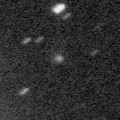
|
Now it is 17.0 mag (Mar. 2, Thomas Lehmann). It is expected to brighten up to 9 mag in summer in 2018. In the Northern Hemisphere, it stays observable until 2018 summer while the comet will be brightening. In the Southern Hemisphere, it is hardly observable in 2017, but it will be observable in good condition in 2018.
Date(TT) R.A. (2000) Decl. Delta r Elong. m1 Best Time(A, h)
Mar. 25 19 10.89 48 8.6 5.672 5.578 79 16.2 4:32 (233, 60)
Apr. 1 19 12.17 48 49.8 5.579 5.522 81 16.2 4:21 (230, 62)
|
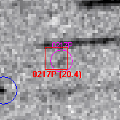
|
It will brighten rapidly, and it is expected to brighten up to 12 mag from July to September. In the Southern Hemisphere, it stays at the same altitude in the morning sky. In the Northern Hemisphere, it will be getting higher slowly.
Date(TT) R.A. (2000) Decl. Delta r Elong. m1 Best Time(A, h)
Mar. 25 21 15.64 -13 44.0 2.369 1.843 47 16.5 4:32 (294, 9)
Apr. 1 21 34.58 -12 44.9 2.268 1.787 49 16.2 4:21 (293, 9)
|

|
It stayed bright 12 mag for a long time from autum in 2015 to summer in 2016. Now it is fading. It has already faded dwon to 16.4 mag (Feb. 15, T. Ikemura, H. Sato).
Date(TT) R.A. (2000) Decl. Delta r Elong. m1 Best Time(A, h)
Mar. 25 17 22.85 -8 1.5 4.271 4.605 103 16.4 4:32 (345, 46)
Apr. 1 17 20.57 -8 24.3 4.210 4.656 110 16.5 4:21 (352, 46)
|
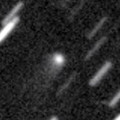
|
Now it is 16.0 mag (Feb. 16, Alexander Baransky). It stays 16 mag for a long time from 2017 to 2018.
Date(TT) R.A. (2000) Decl. Delta r Elong. m1 Best Time(A, h)
Mar. 25 8 25.93 3 10.9 5.029 5.626 122 16.5 20:14 ( 0, 58)
Apr. 1 8 22.55 4 24.5 5.117 5.610 114 16.5 19:46 ( 2, 59)
|

|
Now it is 16.2 mag (Mar. 4, T. Ikemura, H. Sato). It stays 16.5 mag from 2016 to 2017. In the Northern Hemisphere, it stays observable in good condition for a long time. In the Southern Hemisphere, it will never be observable again.
Date(TT) R.A. (2000) Decl. Delta r Elong. m1 Best Time(A, h)
Mar. 25 18 54.97 49 8.1 6.341 6.285 82 16.6 4:32 (230, 62)
Apr. 1 18 58.14 50 38.0 6.318 6.291 83 16.6 4:21 (225, 63)
|
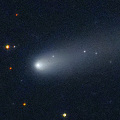
|
It brightened up to 11-12 mag from summer to autumn in last year. Now it is fading. It has already faded down to 14.9 mag (Mar. 3, T. Ikemura, H. Sato).
Date(TT) R.A. (2000) Decl. Delta r Elong. m1 Best Time(A, h)
Mar. 25 11 51.72 -24 30.1 1.596 2.542 156 16.7 23:39 ( 0, 31)
Apr. 1 11 45.47 -23 13.2 1.640 2.589 156 16.9 23:05 ( 0, 32)
|

|
It has not been observed since last April. Now it is fading. But it must be bright as 17 mag still now.
Date(TT) R.A. (2000) Decl. Delta r Elong. m1 Best Time(A, h)
Mar. 25 17 10.26 -19 14.2 2.655 3.083 106 17.0 4:32 (352, 35)
Apr. 1 17 10.50 -18 50.7 2.628 3.154 112 17.1 4:21 (356, 36)
|
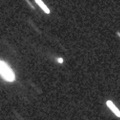
|
Now it is 16.5 mag (Feb. 23, T. Ikemura, H. Sato). It brightened rapidly, and became brighter than originally expected. It stays 17 mag until 2017. In the Northern Hemisphere, it stays observable in excellent condition for a long time. It is not observable in the Southern Hemisphere.
Date(TT) R.A. (2000) Decl. Delta r Elong. m1 Best Time(A, h)
Mar. 25 12 27.10 61 25.9 6.916 7.420 116 17.0 0:19 (180, 64)
Apr. 1 12 16.79 61 11.6 6.963 7.429 114 17.1 23:36 (180, 64)
|

|
Now it is 17.3 mag (Mar. 6, iTelescope Observatory, Siding Spring). It will brighten up to 15.5 mag in summer. It will be observable in excellent condition in the Southern Hemisphere. It locates somewhat low in the Northern Hemisphere.
Date(TT) R.A. (2000) Decl. Delta r Elong. m1 Best Time(A, h)
Mar. 25 20 12.66 -46 35.1 2.906 2.760 71 17.2 4:32 (327, -4)
Apr. 1 20 27.71 -46 1.1 2.806 2.729 75 17.1 4:21 (327, -4)
|
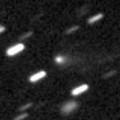
|
Now it is 17.0 mag (Mar. 2, Kunihiro Shima). It is observable in excellent condition in the Northern Hemisphere. It locates low in the Southern Hemisphere.
Date(TT) R.A. (2000) Decl. Delta r Elong. m1 Best Time(A, h)
Mar. 25 6 54.38 31 45.5 3.263 3.531 97 17.1 19:40 ( 78, 78)
Apr. 1 6 59.61 31 18.8 3.373 3.545 91 17.2 19:46 ( 84, 72)
|
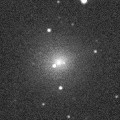
|
It brightened up to 11-12 mag in autumn. Now it is fading. It has already faded down to 16.9 mag (Mar. 3, T. Ikemura, H. Sato).
Date(TT) R.A. (2000) Decl. Delta r Elong. m1 Best Time(A, h)
Mar. 25 13 38.21 -15 18.2 1.595 2.537 155 17.1 1:30 ( 0, 40)
Apr. 1 13 31.69 -14 35.7 1.611 2.586 163 17.4 0:56 ( 0, 40)
|
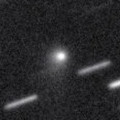
|
It brightened up to 15 mag in early 2016. Now it is fading. It has already faded down to 17.1 mag (Mar. 3, K. Hills). In the Northern Hemisphere, it stays observable in good condition for a long time until autumn when the comet will be fainter than 18 mag. It will never be observable after this in the Southern Hemisphere.
Date(TT) R.A. (2000) Decl. Delta r Elong. m1 Best Time(A, h)
Mar. 25 15 10.30 72 2.9 6.253 6.521 101 17.1 3:01 (180, 53)
Apr. 1 15 0.55 72 13.2 6.301 6.551 100 17.2 2:23 (180, 53)
|
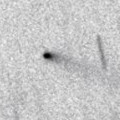
|
Now it is 17.0 mag (Feb. 16, Alexander Baransky). It was observed at 17 mag last winter. It will be observable at 17 mag again next winter. It is observable in good condition in the Northern Hemisphere. But it locates low in the Southern Hemisphere.
Date(TT) R.A. (2000) Decl. Delta r Elong. m1 Best Time(A, h)
Mar. 25 11 1.76 41 11.8 3.491 4.244 133 17.5 22:49 (180, 84)
Apr. 1 10 58.82 41 53.2 3.584 4.274 128 17.6 22:19 (180, 83)
|
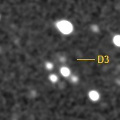
|
Now it is 17.1 mag (Mar. 7, iTelescope Observatory, Siding Spring). It is observable at 17.5 mag in good condition in spring. It locates somewhat low in the Northern Hemisphere.
Date(TT) R.A. (2000) Decl. Delta r Elong. m1 Best Time(A, h)
Mar. 25 12 54.29 -30 57.3 4.089 4.973 149 17.5 0:46 ( 0, 24)
Apr. 1 12 45.91 -29 24.7 4.047 4.971 155 17.5 0:10 ( 0, 25)
|
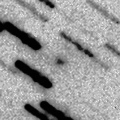
|
Now it is 17.8 mag (Feb. 28, T. Ikemura, H. Sato). In the Northern Hemisphere, it is observable at 17-18 mag until March. It is not observable in the Southern Hemisphere.
Date(TT) R.A. (2000) Decl. Delta r Elong. m1 Best Time(A, h)
Mar. 25 10 23.68 78 38.7 1.796 2.176 98 17.6 22:07 (180, 47)
Apr. 1 9 41.99 73 23.4 1.856 2.217 97 17.8 21:01 (180, 52)
|
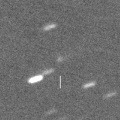
|
Now it is 17.8 mag (Feb. 3, T. Ikemura, H. Sato). It is observable at 17.5 mag in good condition from winter to spring.
Date(TT) R.A. (2000) Decl. Delta r Elong. m1 Best Time(A, h)
Mar. 25 15 10.59 -11 41.9 1.634 2.447 135 17.7 3:01 ( 0, 43)
Apr. 1 15 8.64 -11 38.4 1.595 2.466 142 17.7 2:32 ( 0, 43)
|

|
Now it is 17.9 mag (Mar. 3, T. Ikemura, H. Sato). It stays observable in good condition for a while, but it will be fainter than 18 mag in April.
Date(TT) R.A. (2000) Decl. Delta r Elong. m1 Best Time(A, h)
Mar. 25 12 28.02 4 43.6 1.850 2.842 172 17.7 0:20 ( 0, 60)
Apr. 1 12 22.77 5 31.3 1.886 2.873 169 17.8 23:42 ( 0, 60)
|
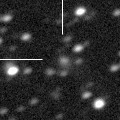
|
Now it is 17.0 mag (Mar. 13, E. Primucci). In the Southern Hemisphere, it is observable at 17.5 mag in good condition in spring. It is hardly observable in the Northern Hemisphere.
Date(TT) R.A. (2000) Decl. Delta r Elong. m1 Best Time(A, h)
Mar. 25 13 2.14 -45 58.0 5.127 5.871 134 17.7 0:54 ( 0, 9)
Apr. 1 12 58.53 -45 12.5 5.092 5.883 139 17.7 0:22 ( 0, 10)
|
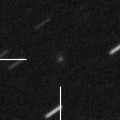
|
Now it is 18.0 mag (Feb. 28, Yasukazu Ikari). It is observable in good condition in the Southern Hemisphere.
Date(TT) R.A. (2000) Decl. Delta r Elong. m1 Best Time(A, h)
Mar. 25 5 46.18 -22 37.0 3.858 3.880 83 17.8 19:40 ( 32, 25)
Apr. 1 5 47.69 -20 9.1 3.951 3.887 79 17.9 19:46 ( 41, 23)
|
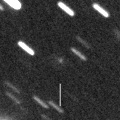
|
It stays at 14 mag for a long time from 2018 to 2019. In the Northern Hemisphere, it stays observable in good condition while the comet will be brightening gradually. In the Southern Hemisphere, it is not observable until 2018 October.
Date(TT) R.A. (2000) Decl. Delta r Elong. m1 Best Time(A, h)
Mar. 25 18 33.06 44 7.4 5.333 5.352 85 17.9 4:32 (238, 67)
Apr. 1 18 32.34 45 50.9 5.233 5.300 88 17.8 4:21 (232, 69)
|
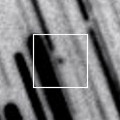
|
It will be observable at 17.5 mag in good condition from April to May.
Date(TT) R.A. (2000) Decl. Delta r Elong. m1 Best Time(A, h)
Mar. 25 18 27.69 -4 42.9 2.197 2.368 87 18.0 4:32 (322, 43)
Apr. 1 18 18.71 -5 41.2 2.066 2.388 96 17.9 4:21 (331, 45)
|
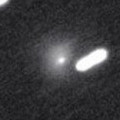
|
Very far object. Outburst occured on Feb. 20, 2015, and it brightened up to 15 mag. Now it is 17.8 mag (June 4, Space Surveillance Telescope, Atom Site). It is observable in excellent condition in the Southern Hemisphere. It locates low in the Northern Hemisphere.
Date(TT) R.A. (2000) Decl. Delta r Elong. m1 Best Time(A, h)
Mar. 25 14 41.22 -26 35.8 8.619 9.374 137 17.9 2:32 ( 0, 28)
Apr. 1 14 39.81 -26 28.8 8.552 9.380 144 17.9 2:03 ( 0, 28)
|
|
![]()
 73P/Schwassmann-Wachmann 3
73P/Schwassmann-Wachmann 3 C/2017 E1 ( Borisov )
C/2017 E1 ( Borisov ) 71P/Clark
71P/Clark C/2016 VZ18 ( PanSTARRS )
C/2016 VZ18 ( PanSTARRS ) 29P/Schwassmann-Wachmann 1
29P/Schwassmann-Wachmann 1 45P/Honda-Mrkos-Pajdusakova
45P/Honda-Mrkos-Pajdusakova C/2016 R2 ( PanSTARRS )
C/2016 R2 ( PanSTARRS ) 315P/2013 V6 ( LONEOS )
315P/2013 V6 ( LONEOS ) 65P/Gunn
65P/Gunn C/2015 O1 ( PanSTARRS )
C/2015 O1 ( PanSTARRS ) C/2015 VL62 ( Lemmon-Yeung-PanSTARRS )
C/2015 VL62 ( Lemmon-Yeung-PanSTARRS ) C/2011 KP36 ( Spacewatch )
C/2011 KP36 ( Spacewatch ) C/2016 N4 ( MASTER )
C/2016 N4 ( MASTER ) 93P/Lovas 1
93P/Lovas 1 213P/Van Ness
213P/Van Ness C/2014 B1 ( Schwartz )
C/2014 B1 ( Schwartz ) 81P/Wild 2
81P/Wild 2 74P/Smirnova-Chernykh
74P/Smirnova-Chernykh C/2016 B1 ( NEOWISE )
C/2016 B1 ( NEOWISE ) C/2016 M1 ( PanSTARRS )
C/2016 M1 ( PanSTARRS ) 217P/LINEAR
217P/LINEAR C/2014 W2 ( PanSTARRS )
C/2014 W2 ( PanSTARRS ) C/2016 A1 ( PanSTARRS )
C/2016 A1 ( PanSTARRS ) C/2014 OE4 ( PanSTARRS )
C/2014 OE4 ( PanSTARRS ) 43P/Wolf-Harrington
43P/Wolf-Harrington C/2015 TQ209 ( LINEAR )
C/2015 TQ209 ( LINEAR ) C/2014 R3 ( PanSTARRS )
C/2014 R3 ( PanSTARRS ) C/2017 D2 ( Barros )
C/2017 D2 ( Barros ) P/2015 TP200 ( LINEAR )
P/2015 TP200 ( LINEAR ) 144P/Kushida
144P/Kushida C/2013 V4 ( Catalina )
C/2013 V4 ( Catalina ) C/2015 X7 ( ATLAS )
C/2015 X7 ( ATLAS ) C/2017 D3 ( ATLAS )
C/2017 D3 ( ATLAS ) C/2016 T2 ( Matheny )
C/2016 T2 ( Matheny ) 94P/Russell 4
94P/Russell 4 118P/Shoemaker-Levy 4
118P/Shoemaker-Levy 4 C/2017 E3 ( PanSTARRS )
C/2017 E3 ( PanSTARRS ) C/2017 A3 ( Elenin )
C/2017 A3 ( Elenin ) C/2016 N6 ( PanSTARRS )
C/2016 N6 ( PanSTARRS ) C/2016 T1 ( Matheny )
C/2016 T1 ( Matheny ) C/2013 C2 ( Tenagra )
C/2013 C2 ( Tenagra )![]()











































